![]()
![]()
![]()
Use LEFT and RIGHT arrow keys to navigate between flashcards;
Use UP and DOWN arrow keys to flip the card;
H to show hint;
A reads text to speech;
20 Cards in this Set
- Front
- Back
|
Mammals general characteristics
|
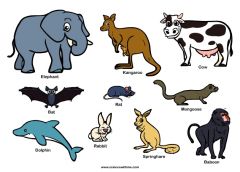
1) hair or fur
2) mammary glands and milk production 3) four chambered heart and endothermic 4) testes descended into a scrotum 5) mostly viviparous (producing living young instead of eggs from within the body in the manner of nearly all mammals, many reptiles, and a few fishes) and lacking a cloaca (the common cavity into which the intestinal, urinary, and generative canals open in birds, reptiles, amphibians, many fishes, and certain mammals.) 6) limbs carried beneath body |
|
|
Mammalia Origins
|
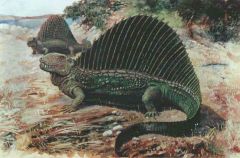
a) synapsids- mammal like reptiles that were the precursors to mammals
1) dominant tetrapod during the Permian period 2) wiped out in Permian/ Triassic extinctions 225 mya ex: dimetrodon |
|
|
Morganucodon- Mammal
|
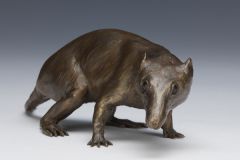
b) first true mammal to emerge during Jurassic period (135 mya); shrew-size
c) during the Mesozoic era (135-70 mya) 3 major lineages of mammals emerged |
|
|
Monotremes- Mammal
|
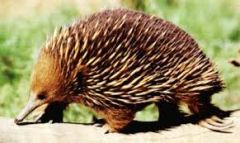
i. Echidna and platypus, found only in Australia and New Guinea
ii. Oviparous (producing eggs that mature and hatch after being expelled from the body, as birds, most reptiles and fishes, and the monotremes.), cloaca, poison spur (males) (egg laying) iii. endothermic, fur, milk (females) |
|
|
Marsupials Mammals
|
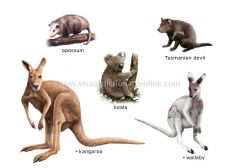
i. found in australia and n/s america
ii. higher metabolic rate than monotremes iii. endothermic, fur, milk (females) iv. offspring born prematurely, finish development in pouch |
|
|
Eutherians (placentals-humans) Mammals : possums and kangaroos
|
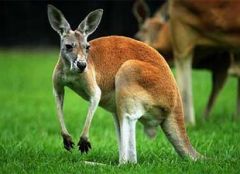
i. found wold wide
ii. endothermic, fur, milk (females) iii. longer gestation period than marsupials iv. offspring complete development in the uterus due to a more developed placenta |
|
|
Derived characters of primates (chimpanzee)
|
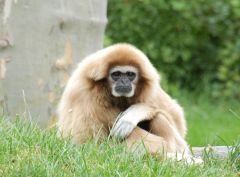
a) hands and feet adapted for grasping
b) nails instead of claws c) large brain+short jaw= flat face d) well developed parental care and complex social behaviors ex: gibbon |
|
|
Primates General Characteristics (Tarsier)
|
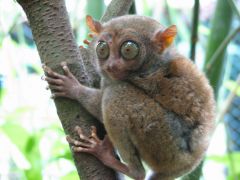
a) earliest primates were arboreal (tree living)
b) hands and feet were adapted for grasping c) opposable thumbs d) binocular vision with good eye-hand coordination (helps with depth perception) |
|
|
Primata: Old world Monkeys
|
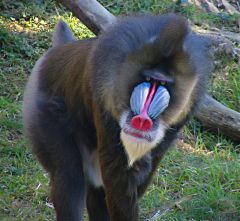
i. Africa, Asia, Madagascar
ii. include monkeys and lemurs iii. arboreal and ground-dwelling iv. diurnal (active mainly during the day) ex: mandrill from Lion King |
|
|
Primata: New World Monkeys
|
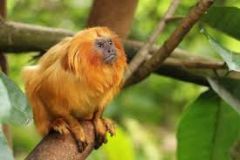
i. South America
ii. Monkeys iii. Arboreal iv. diurnal ex: golden lion tamarin |
|
|
Primata: Hominoids (great apes)
|
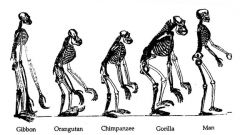
i. Africa, Indonesia
ii. include bonobos, chimpanzees, gibbons, gorillas, orangutans, humans iii. arboreal and ground dwelling iv. diurnal v. diverged from old world monkeys 25 mya vi. long arms, short legs, no tail vii. most are largest primate viii. largest brain among primates ix. behavior is more flexible ex: chimpanzee |
|
|
Hominids (humans and their ancestors)
|
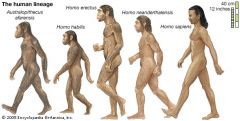
i. upright stance, bipedal
ii. reduced jaw bone and muscles iii. shorter digestive tract (because we eat meat and plants) iv. largest brain among hominoids v. language, symbolic thought, and more advanced tool use |
|
|
Bipedalism
|
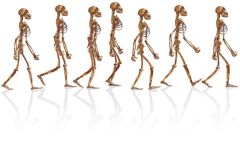
a) 10 mya hominids began to rise
b) transitional modes of locomotion evolved c) changes in environment led to changes in locomotion d) bipedalism required less energy, freeing hands for other purposes |
|
|
Human Evolution: Tool use
|
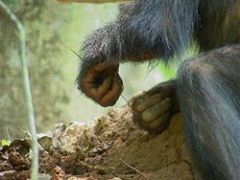
a) simple tool use observed in other hominoids (chimpanzees)
b) more complex tool use first observed in Australoithecines (2.5 mya); cutting tools ex: young chimpanzee termiting with a stick |
|
|
Human evolution: Sahelanthropus tchadensis (6-7 mya) SARAH
|

i. reduced canine teeth
ii. relatively flat faces iii. more upright and bipedal |
|
|
Human evolution: Australopithecus sp. (2-4 mya) AUSTIN
|
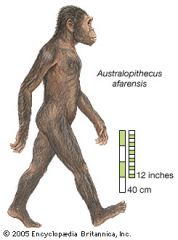
i. smaller heads- smaller brains; tool use
ii. Longer lower jaw iii. upright and bipedal |
|
|
Human Evolution: Homo habilis (1.6-2.4 mya) HECTOR
|

i. larger brain- extensive tool use
ii. shorter jaw |
|
|
Human evolution: Homo erectus (1.5- 1.9 mya) ERIC
|
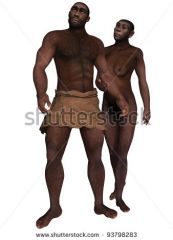
i. larger brain- extensive stone tool use
ii. shorter jaw, smaller teeth iii. longer legs, shorter fingers iv. sexual dimorphism |
|
|
Human evolution: Homo neanderthalensis (160k-195 kya) NICK
|
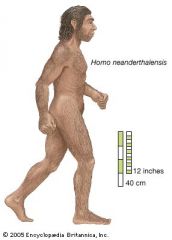
i. larger brain- extensive stone/wood tool use
ii. thick boned, heavy iii. prominent brow ridge iv. not a direct ancestor of Homo sapiens |
|
|
Human Evolution: Homo sapiens (30 k- 600 k) SABRINA
|
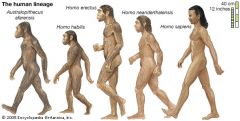
i. emerged out of Africa, then N & E
ii. language, cognition iii. Slender body iv. no prominent brow ridge |

